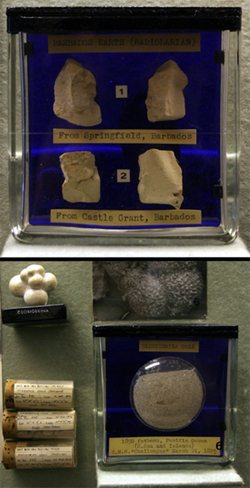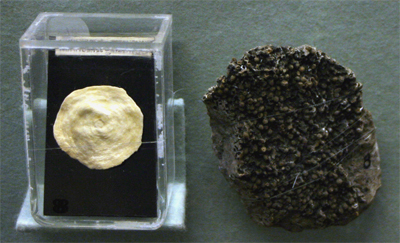
AMOEBAE, OOZE AND ROCKS | |
It is an outstanding fact that over one third of the earth’s sedentary rocks are made of protozoan skeletons. The epic voyage of the H.M.S. Challenger, directed by Charles Wyville Thompson, Professor of Natural History (1872-1882), was dispatched to examine the biological and physical conditions of the great ocean basins. In so doing, the expedition charted the global distribution and composition of the oozes formed on the seafloor by protozoan skeletons. Sir John Murray edited the results in 50 quarto volumes. The findings laid the basis of modern science of oceanography. His book ‘The Ocean’ describes the distribution and composition of the oozes, which formed as the shells and skeletons of countless marine amoebae fell to the seafloor. Above right: Radiolarian ooze from Barbados Below right: Pteropod, globigerina and radiolarian oozes from the Challenger expedition (1875 & 1876). |
 |
Right: Fossil nummulitid foraminiferans formed such thick deposits in the Tertiary that they formed extensive limestone beds. The pyramids at Giza are made of protozoa. Below: Slides of foraminiferans, which build calcareous shells with pores through which fine pseudopods protrude or catch food. From left to right: species found in shallow water (less than 50 fathoms); species from 50 – 150 fathoms; species from 200 – 2300 fathoms in the Atlantic and Pacific Oceans. |
 |
 | |






